I’ve been lucky enough to backpack to Havasu Falls twice, and each trip was an unforgettable adventure.
This iconic Havasu Falls hike, located on Havasupai tribal land, is a bucket list destination for many outdoor lovers. The trail is 10 miles each way, departing from Hualapai Hilltop in Arizona where you descend into a steep canyon and travel through a dry sandy wash all the way to paradise.
It’s a long hike carrying your backpacking gear, but once you arrive and take off your pack, you’ll be rewarded with five incredible waterfalls, turquoise swimming holes around every corner, and relaxing creekside camping.
If Havasu Falls camping is on your bucketlist, there are some important things to know before you go. In this post I cover:
This post is a lengthy one, but by the time you’re done reading, you’ll feel confident, excited, and prepared for a once-in-a-lifetime backpacking trip to Havasu Falls!
Read these other Havasu Falls Posts:
Havasu Falls Hiking Map and GPS File
Below is the trail map that I created for my Havasu Falls hike. If you have a GPS, you can download the Havasu Falls GPS file here for free and upload it to your GPS. If you don’t have a GPS, Gaia premium is $4.99 a month and will allow you to access this map on your phone when you are offline.
Havasu Falls Itinerary
Permits for camping at Havasu Falls are good for 3 nights / 4 days. So how should you spend your time? Luckily there is so much more to do than visiting Havasu Falls. There are a total of 5 waterfalls in Havasu Canyon that are worth exploring on your camping trip.
Here is my suggested itinerary for a perfect Havasu Falls camping trip:
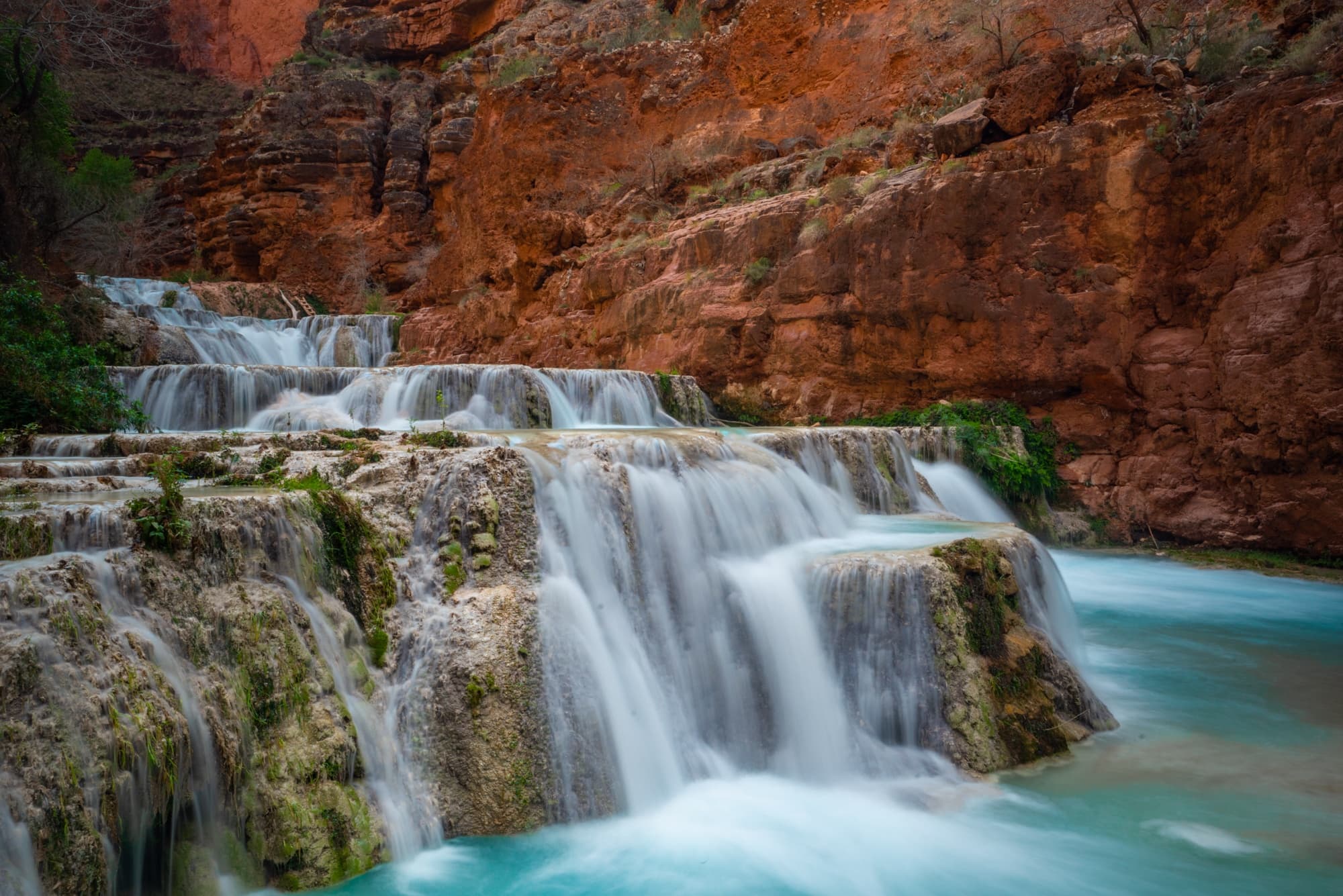
Havasu Falls Trail Description
Trail Stats
The total distance to the Havasu Falls campground is approximately 10 miles one way. The trail begins at the Hualapai Hilltop parking lot at an elevation of 5,200 feet.
From the Hualapai Hilltop trailhead, the trail begins an immediate 800-foot descent over the first mile, dropping you into Havasu Canyon which you can see below.
The hike on the way in is long but not too difficult and the initial descent is on a well-maintained series of switchbacks.
Once you reach the wash, the trail follows a dry river bed for the next 6.5 miles, gradually dropping another 1,200 feet. Here, the hiking can be a bit slow due to the sandy gravel, but the trail is very easy to follow.
If at any point you think you’ve lost the trail, just keep following the river bed until you meet back up with the worn path.
As you get closer to the Supai Village, the canyon chokes up and gets narrower. Here we were able to get some reprieve from the sun.
At 6.2 miles, you’ll reach an intersection with the Supai Trail and Havasu Creek. Here you’ll turn left. Soon you’ll start to see homes belonging to the Havasupai people. Stay on the trail and follow the signs to the village.
At mile 7.5, you’ll enter Supai village. No photos or videos are allowed in this area, and there may be signs asking you to wear a face mask as you walk through the village. Please be respectful and obey the current wishes of the Havasupai Tribe.
In the village, once you get to the Village Market, the road turns left. Continue on here and follow any signs pointing you towards the campground.
Once you pass through the Supai village, it’s another 2 miles and 150 feet of elevation loss down to the Havasupai campground.
Before you get to Havasu Falls, you’ll pass two other waterfalls at the halfway point – Fifty Foot Falls and Navajo Falls. These are located one mile from the Supai Village and one mile from the Havasu Falls campground.
Depending on the time of day, you might consider stopping to explore. If it’s getting late, you can skip these and come back to enjoy them on another day of your trip.
From Navajo Falls, it’s one more mile to the campground. First you’ll cross Havasu Creek on a bridge. Then as you approach the campground, the trail hugs the left side of Havasu Creek where it spills over Havasu Falls. This is a great vantage point of the waterfall and the pools below.
Here, I suggest taking a couple of photos but rather than stopping, continue another quarter mile to the entrance to Havasu Campground so you find a good campsite and drop your pack.
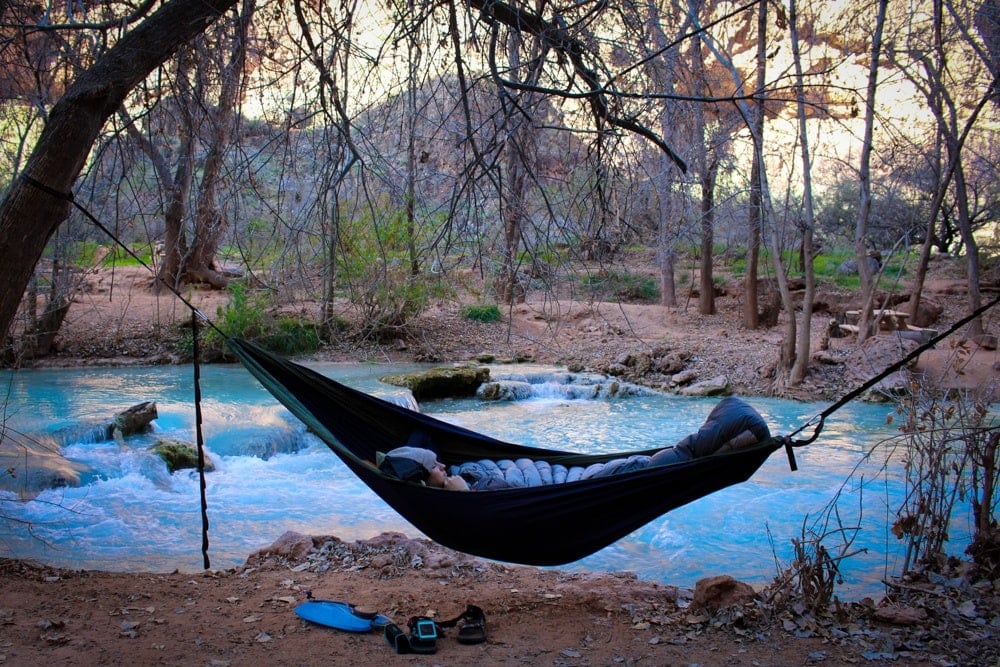
You’ll have plenty of time to explore the other Havasupai waterfalls over the next couple of days, but if you’re eager to see what you’re in for, the view point looking down on Mooney Falls is just a few minutes hike from the campsites.
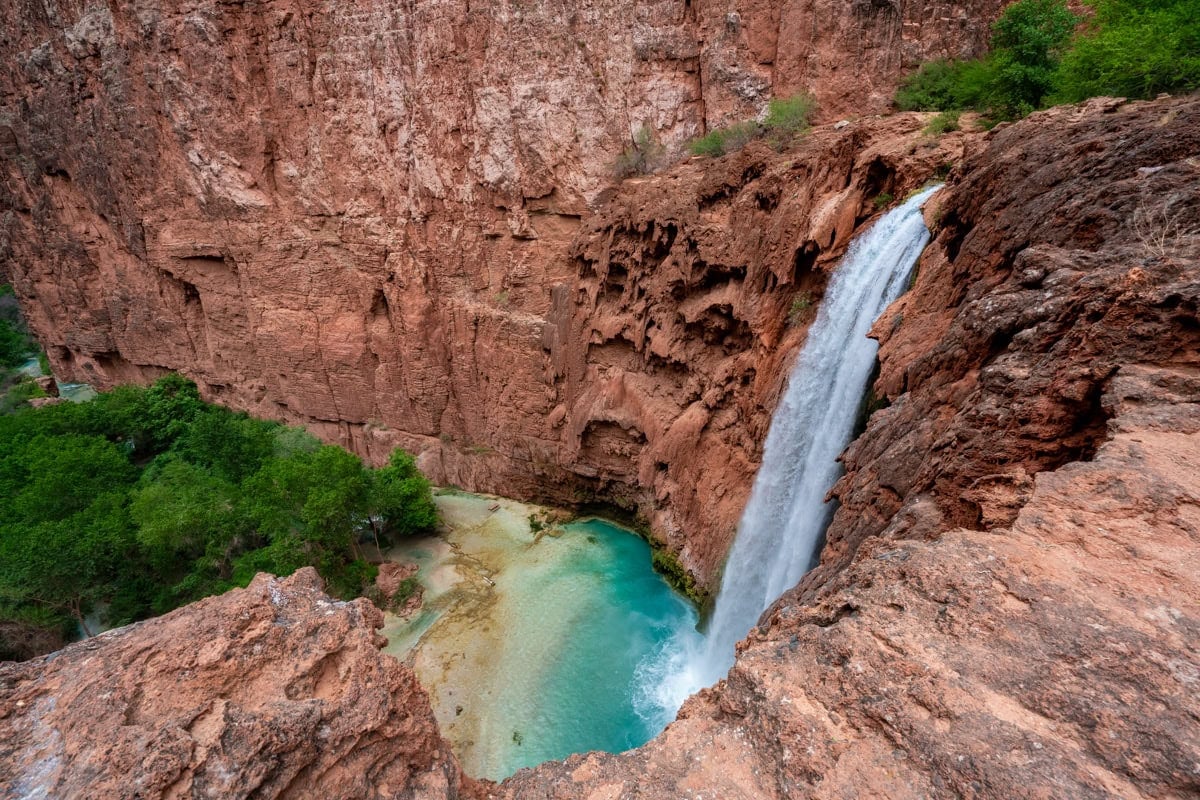
Havasu Falls Hiking Tips
Here are a few important tips that will help you have a more enjoyable hike to and from the Havasu Falls campground.
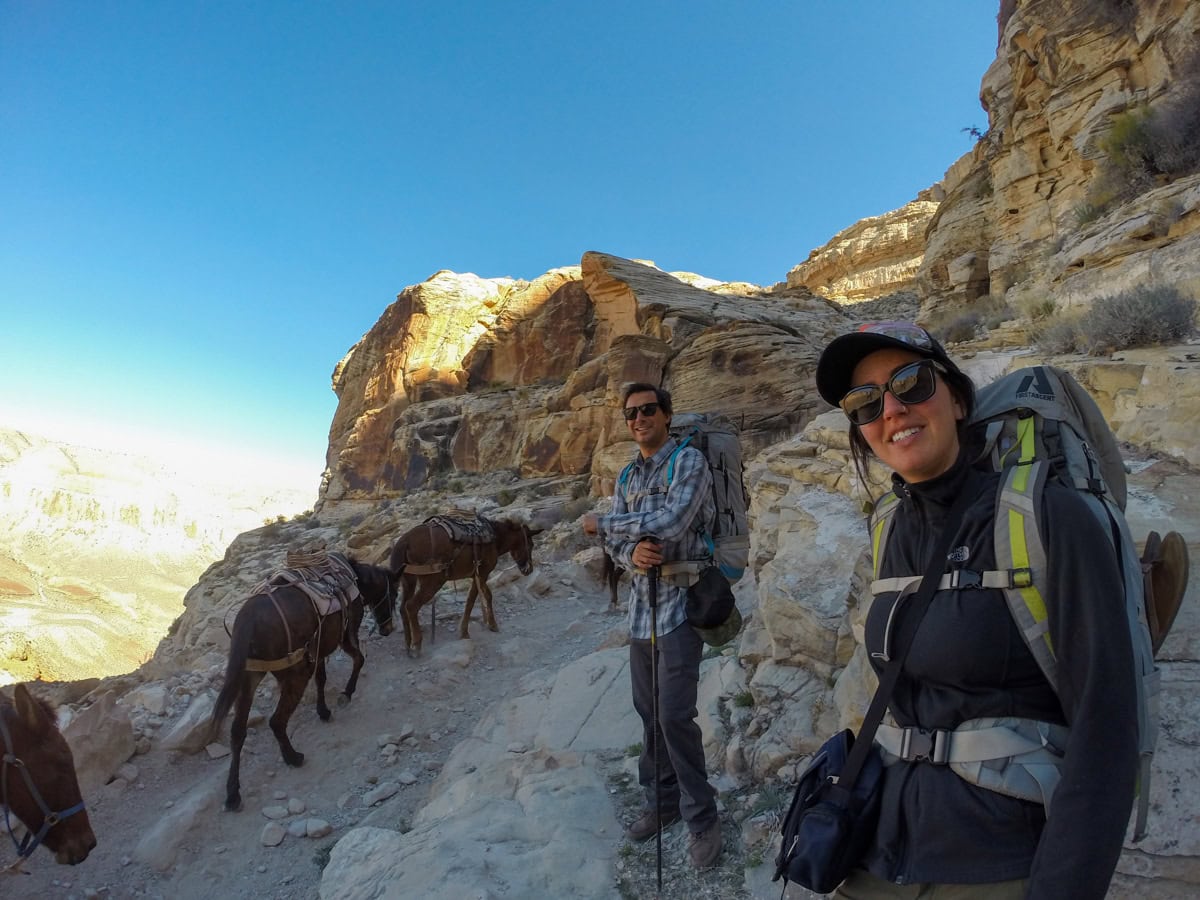
What to Expect at the Havasu Falls Campground
The Havasu Falls campground is quite big and runs more than half a mile along the trail between Havasu and Mooney Falls below. There are spots on both sides of the creek, so I when I was there, I really poked around before settling on a spot.
Do not expect solitude at the campground. The Havasu Falls campground can accommodate 300 campers, so you will have neighbors and some of them may be close.
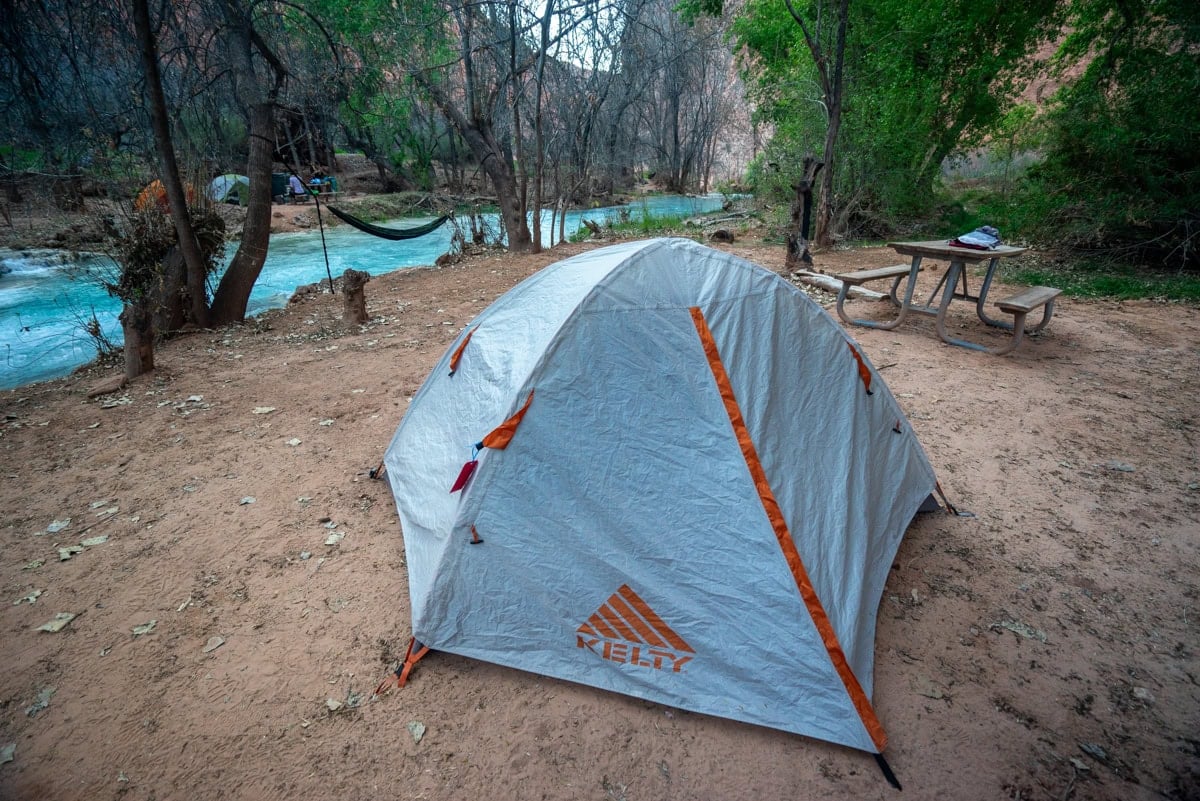
Here is what you should expect:
Rules and How to be a Responsible Visitor
Havasu Falls is located on the western edge of the Grand Canyon and has been occupied by the Havasupai people for more than 800 years. This is their home, the land and waterfalls are sacred, and it’s important to remember what a privilege it is to be a visitor there.
With that in mind, please educate yourself on the current rules and follow them during your visit. Also, be kind and respectful to any Tribe members you encounter.
Here’s an overview of the Tribe’s rules and tips for being a responsible visitor on your Havasu Falls camping trip:
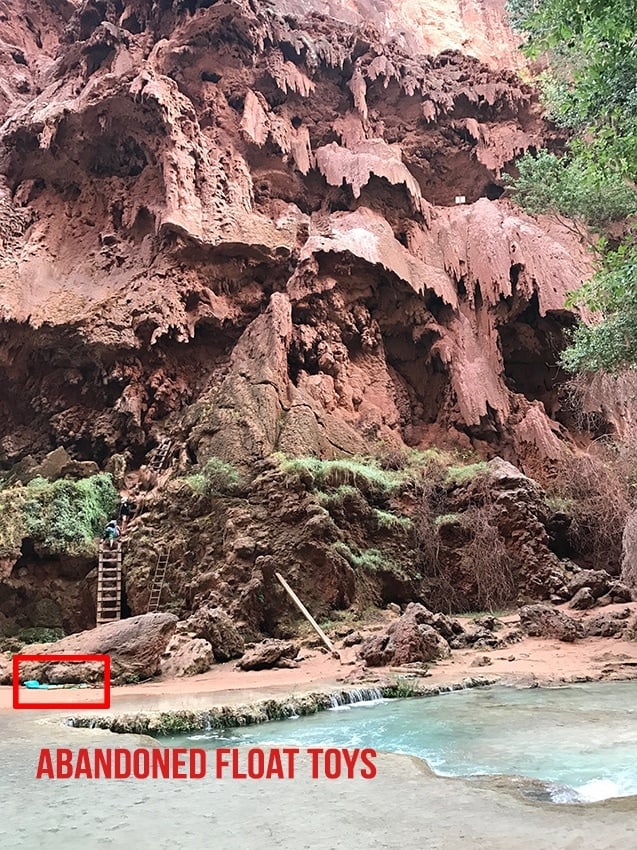
Havasu Falls Permits
Advanced permits are required in order to camp at Havasu Falls. You must secure one online through the Havasupai Reservations website and pick up your permit in person at the Grand Canyon Caverns Inn near Seligman, which is 90 miles from the Trailhead.
The permit process is a bit confusing, so I wrote up an entire blog post with step-by-step instructions for getting a permit. Permits become available on February 1 for the entire year.
→ For more details, see my Havasu Falls Permit Guide.
Don’t think you’ll be able to sneak in – permits are highly regulated at Havasupai. There is a guard stationed on the road about 5 miles from the trailhead who checks permits for every person in your group. Additionally, each vehicle must have a copy of its reservation displayed in its window.
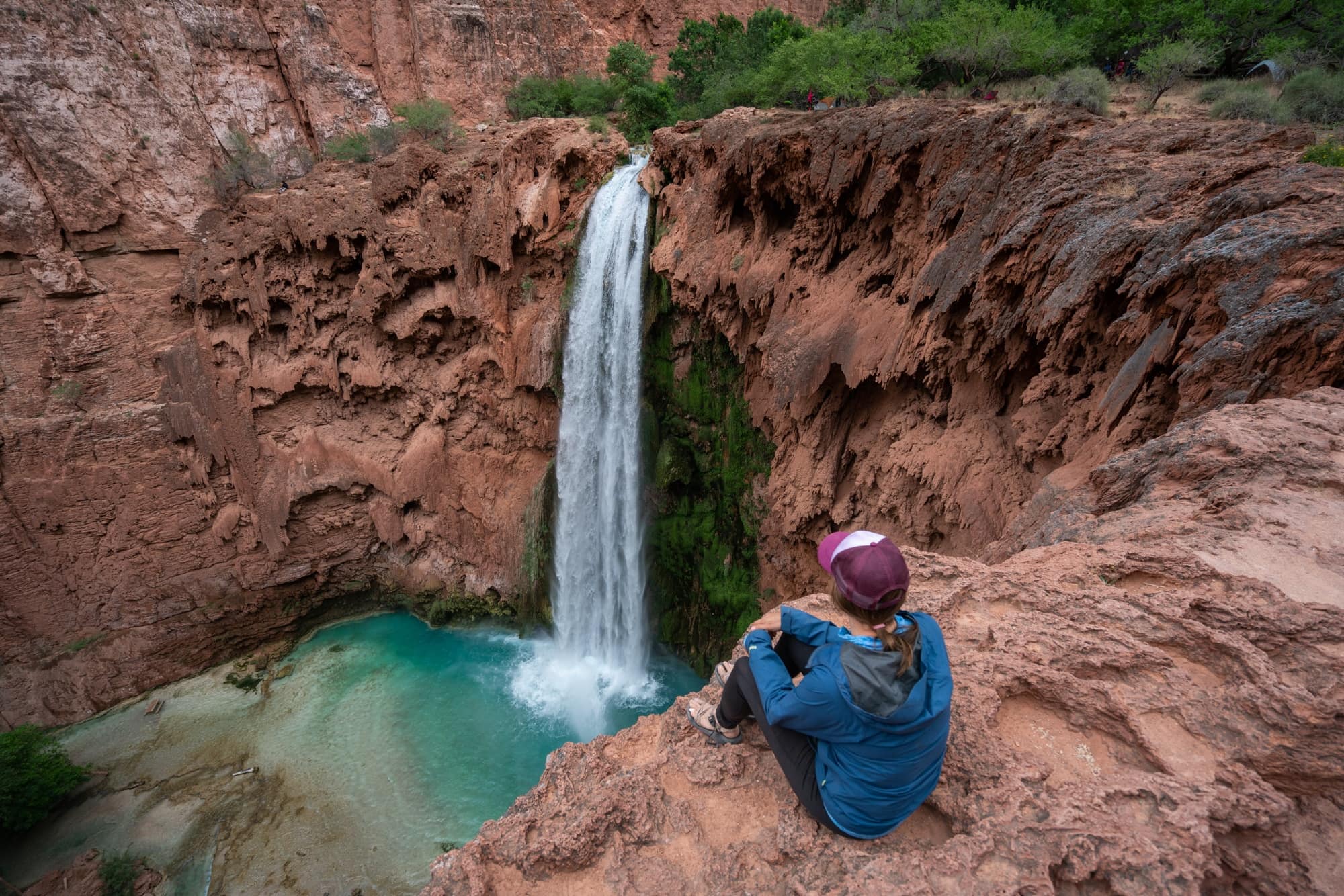
How to Get to the Havasu Falls Campground
There are two ways to get to the Havasu Falls Campground. A majority of people hike since helicopter rides are not guaranteed. I would suggest that you should plan a trip to the Havasu Falls campground unless you are willing and able to hike.
Hiking
The main way that most people get to the Havasu Falls campground is by hiking. It’s 10 miles each way. The hike in is long, but fairly easy as it’s all downhill. The hike back to the car is more challenging due to the 2,200 feet of elevation gain and the sun exposure.
→ Check out my Havasu Falls Hiking Guide for everything you need to know to prepare for the hike to the campground.
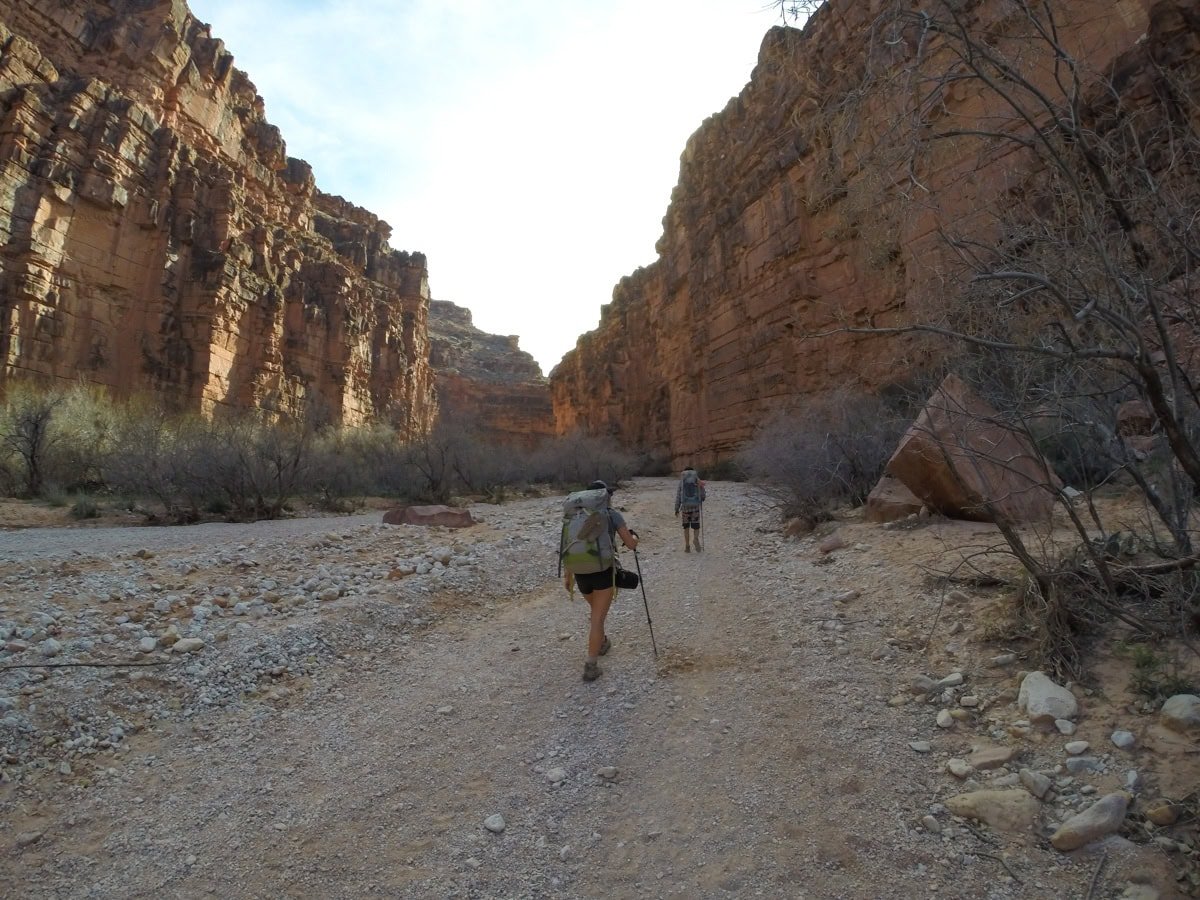
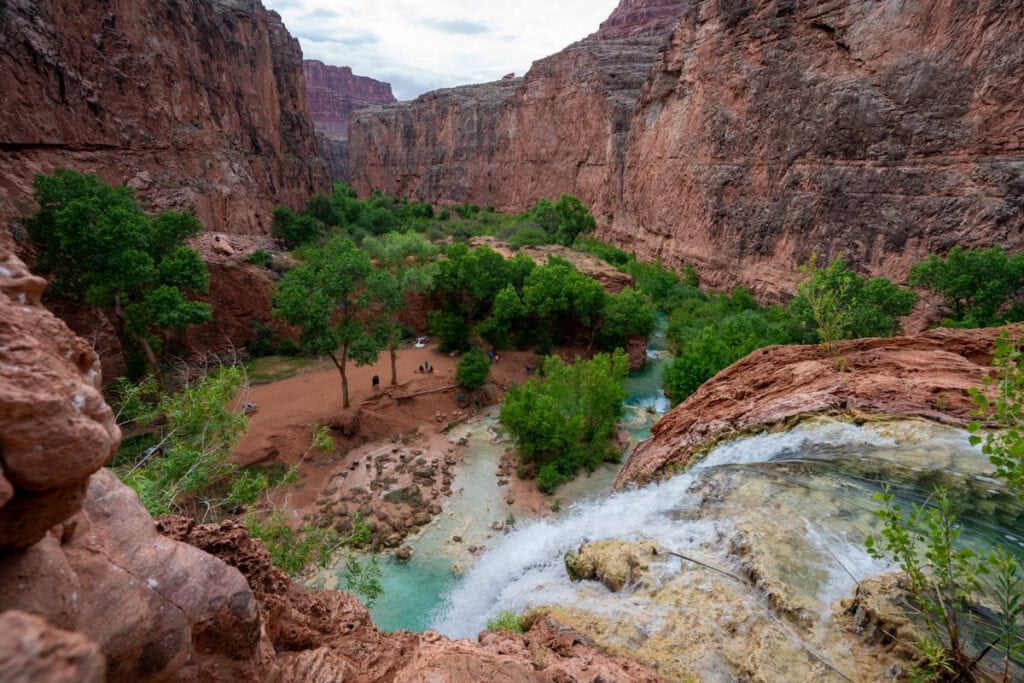
Helicopter
If you’d rather not hike to or from Havasu Falls, there’s a first-come, first-serve helicopter that leaves from both the Hilltop Trailhead and the landing pad in Supai Village.
It’s operated by a private company called Airwest Helicopters. It flies from March 15 to October 15 on Thursdays, Fridays, Sundays, and Mondays, and the rest of the year it only flies Sundays and Fridays. Call (623) 516-2790 for the latest info.
In the past, it cost $100/person (tack on a $10 fee if paying by credit card), and you are allowed to bring one bag on the helicopter up to 40lbs.
The thing is they don’t take reservations, and it’s not guaranteed you will be able to use it. Locals and Tribe Members get first priority, and the helicopter doesn’t fly in bad weather. This means that you shouldn’t rely on the helicopter, and you should always be prepared to get to the campground by foot if you don’t make it on the chopper.
While I’ve personally never taken the helicopter, when BFT contributor Courtney Stephenson visited, she took the helicopter out to save time and energy for the drive home. She started the hike from the campground to the village at 5:30am and was #9 in line for a ride out.
Flights begin around 10am so be prepared to arrive early and wait around. The helicopter takes 6 passengers at the time, and based on the number of locals, she ended up on the 3rd ride out of the day, arriving back to her car by 11am.
I imagine if you’re trying to fly out in peak summer heat, you need to arrive even earlier and be prepared to wait for hours. They will continue flying until everyone is accommodated or until it gets dark.
Courtney said that taking the helicopter was a unique experience (what other backpacking trip can you take a helicopter out of?!) with stunning views of the canyon.
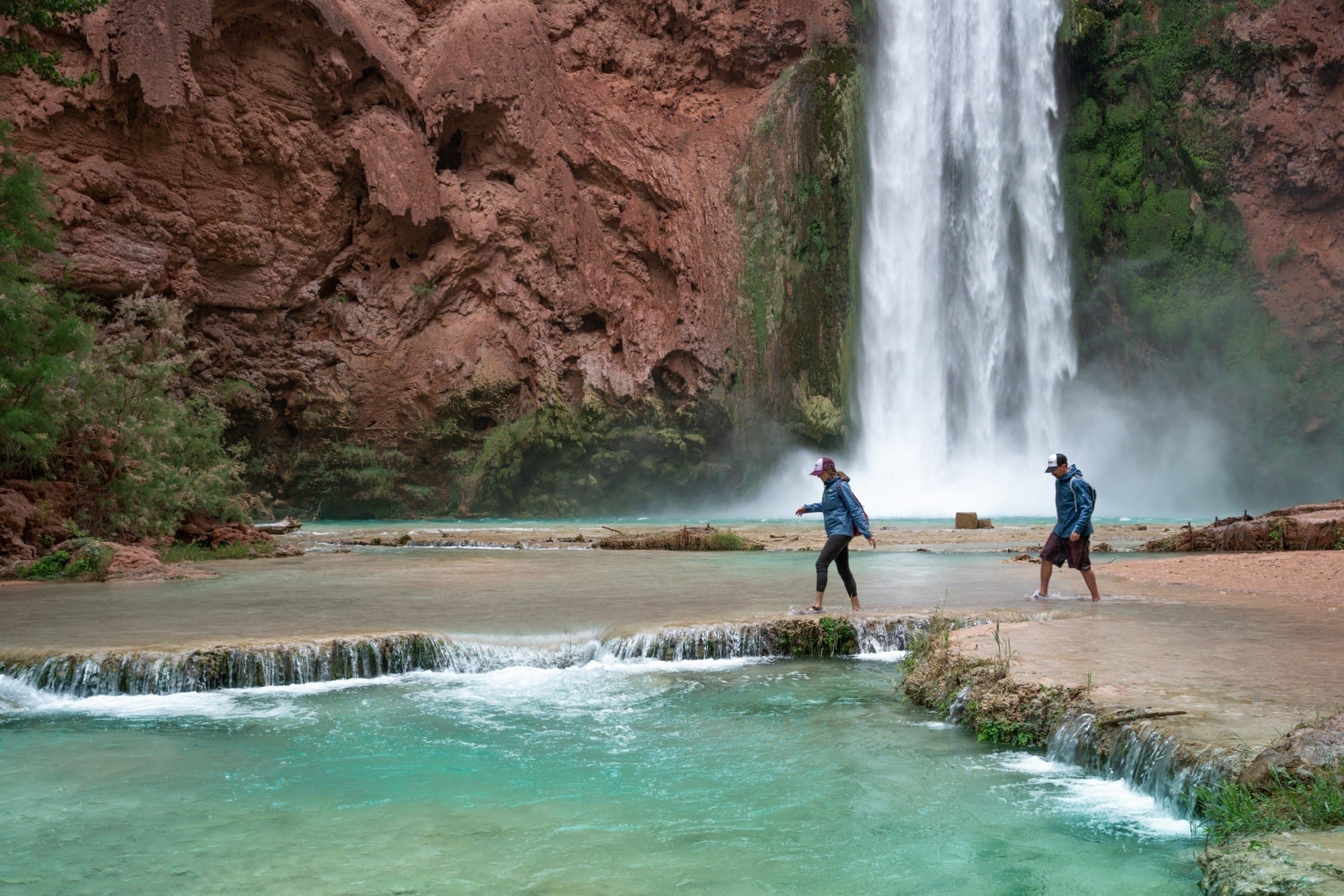

Plan for the whole day. Bring a day pack with water, lunch, a lightweight towel, sun protection, and a swimsuit. Also, wear a quality pair of water shoes. Don’t wear flip-flops!
What Camping Gear to Pack
For your 4-day / 3-night trip to Havasupai, you need to pack in AND OUT all of your gear and supplies. This includes food, supplies, trash, and camping gear.
→ For a complete list of what hiking and camping gear you need for Havasu Falls, check out my full Havasu Falls Packing Checklist.
You’ll want the basics (tent, sleeping bag, tent, sleeping pad, cooking gear, water filter, etc) plus gear for hiking and swimming at the falls, and a bear canister to protect your food.
Water is available at the campground. There is a small store in the village of Supai where you can get basic snacks and drinks, but don’t rely on supplies here.
You’ll want to check the weather ahead of your trip, so you can plan accordingly. A tarp to hang over your picnic table isn’t a bad idea, and a hammock is a nice way to relax at your campsite.
Download my Free Havasu Falls Packing Checklist to your phone so you can make sure you don’t forget anything!
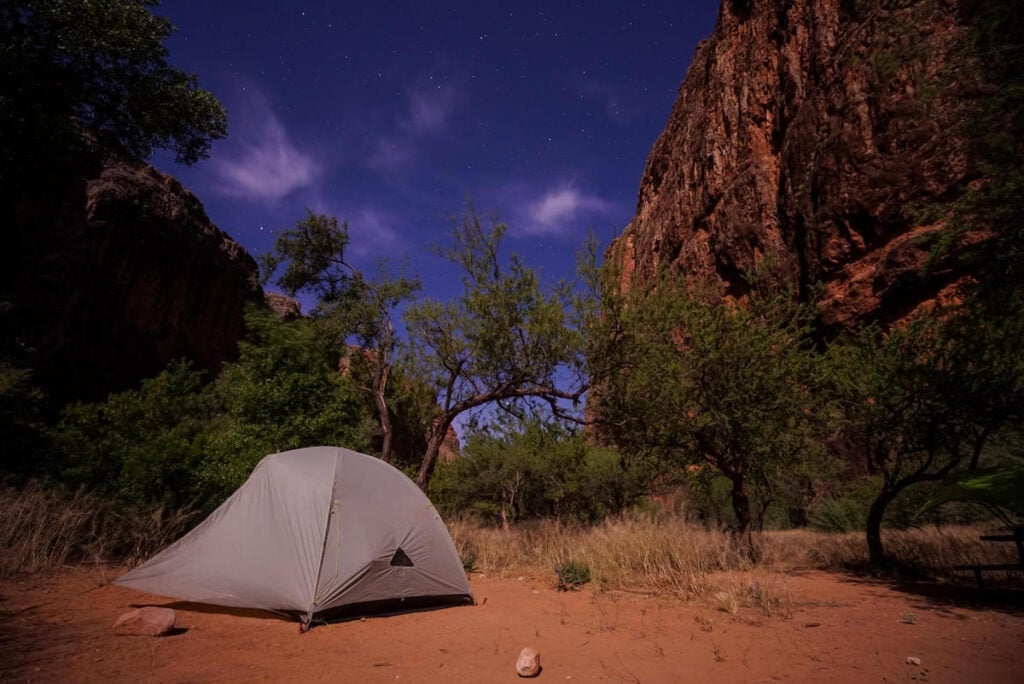
Best Time to Camp at Havasu Falls
The best time to camp at Havasu Falls depends on what you want to do there. Do you want to swim? Or do you want to avoid the crowds? Here are the pros and cons of visiting Havasu Falls in the different months:
February, March, and November
April, May, and October
June, July, August, and September
A note about monsoon season: Monsoon season in Arizona typically runs from mid-June through September. Havasu Canyon has historically seen flooding, including dangerous flash floods. Be prepared by checking the weather forecast, complying with rules and regulations, and paying attention to any alerts from the Rangers.
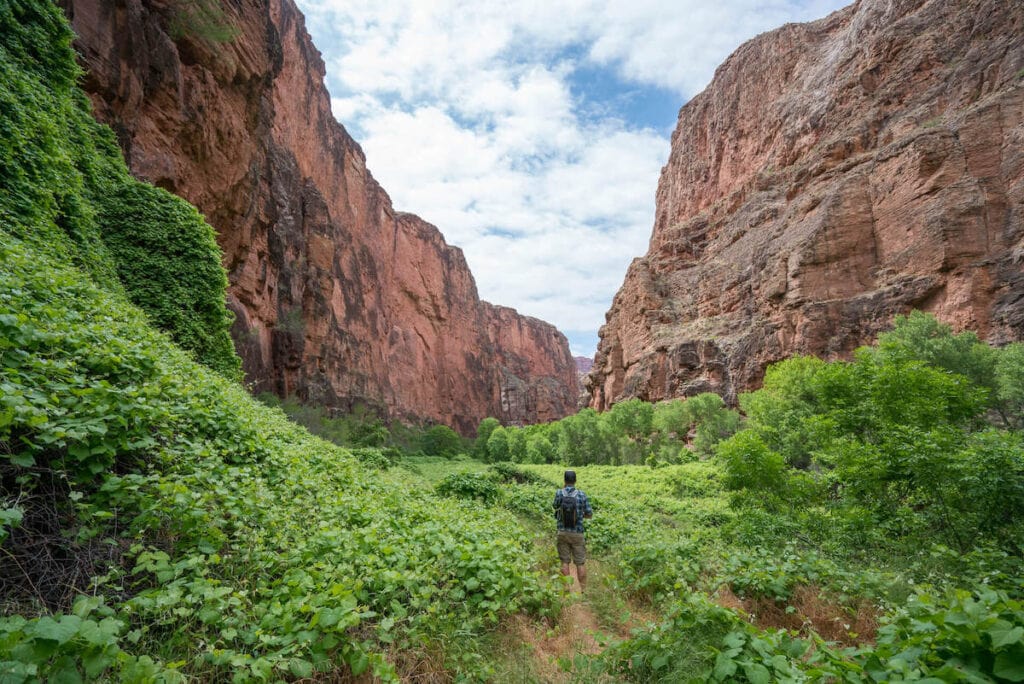
I hope this guide helps you plan an unforgettable camping trip to Havasupai! It’s one of the most special places I’ve ever camped, and I’m sure you will love it too!
Save this post to Pinterest
More Camping Tips
What questions do you have about planning a camping trip to Havasupai? Have you been? Leave a comment below!
The post Planning a Camping Trip to Havasu Falls? This Is the Only Guide You’ll Need appeared first on Bearfoot Theory.
















